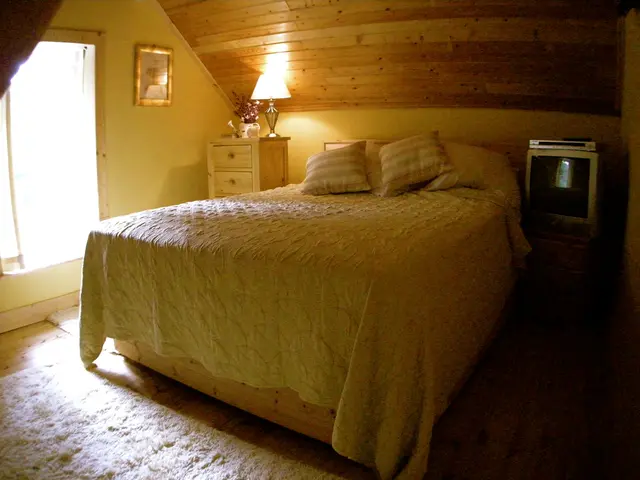Streamlined Living Spaces: Achieving Tranquility and Efficiency through Sparse Decor Design
Minimalist Design: Simplifying Your Space for a Calm and Functional Home
Minimalist interior design is a growing trend aimed at creating clean, open, and functional spaces by focusing on the essentials. This style embraces simplicity, functionality, and the intentional use of decor to achieve a beautiful and efficient home. To understand minimalist design better, this guide will walk you through its core principles and practical tips.
- Embracing Minimalism: Functional Spaces and Simple Elements
Minimalism in interior design revolves around creating functional spaces with simple and purposeful elements. The philosophy is about embracing less, prioritizing essential items, and creating a visually harmonious, organized home environment.
1.1 Clean Lines and Simple Shapes
Clean lines and simple shapes are a key feature of minimalist design, promoting a sense of order and tranquility. This can be achieved by choosing furniture with straight lines, avoiding overly ornate details, and keeping walls and floors free from visual clutter.
1.2 Neutral Color Palettes
Minimalist interiors often embrace neutral colors like whites, grays, blacks, and beiges to create a cohesive, calming atmosphere. By using a neutral base for walls, floors, and large furniture pieces, you can incorporate accent colors through small decorative items like pillows, artwork, or vases.
1.3 Decluttered and Open Spaces
A clutter-free and open layout is a cornerstone of minimalist design, allowing for smooth movement and a sense of space. To achieve this, declutter your home by removing items that don't add value, and use hidden storage solutions to keep things out of sight.
1.4 Functionality and Purpose
Each piece of furniture or decor should serve a clear purpose and contribute to the room's functionality. Choose multi-functional furniture and keep surfaces clear, avoiding decorative objects that don't contribute to the functionality or aesthetic of the space.
- Selecting Minimalist Furniture
In minimalist interior design, furniture plays a significant role in setting the tone of the space. The goal is to choose simple, high-quality pieces that are functional and aesthetically pleasing.
2.1 Opt for Simple, Low-Profile Furniture
Minimalist furniture features clean lines and low profiles to make the space feel open, balanced, and organized. Choose low-profile sofas, slender, streamlined designs, and simple shapes for an uncluttered look.
2.2 Multi-Functional and Practical Pieces
Incorporate multi-functional furniture, such as sofa beds or storage ottomans, to maximize space and reduce clutter. In smaller spaces, opt for modular furniture that can be rearranged as needed.
2.3 Minimalist Decoration
Avoid overly decorated or ornamental furniture in a minimalist design. Instead, focus on functionality and form, keeping pieces simple and elegant.
- Color Palettes and Materials in Minimalist Design
The colors and materials you choose play a crucial role in creating a peaceful, harmonious atmosphere in minimalist interiors. A neutral color palette helps maintain visual calm, while natural materials add warmth and texture.
3.1 Neutral and Subtle Colors
Minimalist interiors often feature a neutral color palette of whites, grays, blacks, and soft tones like beige and taupe to create a cohesive, clean environment. Use soft whites, light grays, and muted tones like charcoal gray, earthy beige, or natural wood finishes to introduce warmth.
3.2 Natural Materials for Texture
Incorporating natural materials like wood, stone, concrete, or metal gives the space an organic feel, balancing the simplicity of minimalist design. Choose wooden furniture, stone tiles, concrete floors, or metallic lighting fixtures to add depth and warmth.
3.3 Soft Textiles for Comfort
Soft textiles can add comfort, warmth, and texture without disrupting the clean lines of the design. Add neutral-colored cushions, wool throws, or linen curtains to introduce comfort without overloading the space with visual clutter.
- Lighting: Enhancing the Minimalist Aesthetic
Lighting plays a critical role in creating a welcoming, functional environment in minimalist interior design. Proper lighting helps highlight the clean lines of the space while also making it feel warm and inviting.
4.1 Natural Light
Maximizing natural light is a key principle of minimalist design, as it helps open up the space and create a bright, airy feel. To achieve this, use large windows, glass doors, skylights, and avoid heavy window treatments.
4.2 Layered Lighting
Minimalist interiors benefit from layered lighting, which includes ambient, task, and accent lighting to create a balanced and functional space. Opt for recessed ceiling lights, desk lamps, pendant lights, and accent lighting to illuminate various areas.
4.3 Subtle, Simple Fixtures
Lighting fixtures in minimalist interiors should be simple, sleek, and unobtrusive, adding function without detracting from the overall design. Use geometric pendant lights, hidden light sources, and adjustable lighting to provide a clean, understated look.
- Creating a Clutter-Free, Organized Space
A minimalist home is clutter-free and organized, allowing you to focus on the essentials without distractions. Creating an organized space is essential to maintaining the minimalist aesthetic.
5.1 Hidden Storage Solutions
Minimalist interiors rely heavily on hidden storage solutions, such as built-in shelves, hidden drawers, under-bed storage, and floating furniture, to keep items organized and out of sight.
5.2 Decluttering Your Space
Minimalism involves reducing clutter and maintaining a clean, organized home. Regularly declutter your home, remove unnecessary items, and use storage baskets, boxes, and organizers to keep everyday items in order without overwhelming the space.
- Personalizing Your Minimalist Space
While minimalist design emphasizes simplicity, it's essential to inject your personal style into the space to make it feel truly yours.
6.1 Art and Decor
Choose simple, bold, and impactful art, such as abstract artwork, black-and-white photography, or geometric art pieces, to add character without overwhelming the walls. Keep decor items to a minimum and focus on a few sculptures, plants, or vases to personalize the space.
6.2 Meaningful Items
Personalization in minimalist design is about selecting meaningful items that reflect your values and style. Display only items that are functional or have personal significance, such as family heirlooms, travel souvenirs, or books that reflect your interests. Keep decor items simple, focusing on quality over quantity.
FAQs: Minimalist Interior Design
- What is the main idea behind minimalist interior design?
- Embrace straightforward spaces with simple, purposeful elements while prioritizing essential items.
- How can I make my home feel cozy while maintaining a minimalist aesthetic?
- Add soft textiles, use natural materials, and incorporate subtle lighting for warmth and coziness.
- Can I have color in a minimalist interior design?
- Yes! Soft accent colors can be applied through decor items, such as pillows, art, or textiles, to add personality and warmth.
- How do I maintain a minimalist interior design?
- Maintain a minimalist interior by regularly decluttering, choosing functional furniture, and incorporating multi-purpose storage solutions.
- Is minimalist design suitable for small spaces?
- Yes! Minimalism can be adapted to family life. Focus on functional, easy-to-clean furniture, hidden storage solutions, and organizational systems to keep the space clutter-free while maintaining comfort and style.
- With the goal of transforming living spaces into functional yet stylish areas, marble countertops can be strategically integrated into minimalist interior design, enhancing the overall aesthetic of the home-and-garden.
- Incorporating minimalist interior-design principles in a lifestyle focused on simplicity and practicality remodeled the kitchen, with sleek marble countertops adding a timeless, modern appeal while adhering to the design's clean lines and uncluttered aesthetics.








